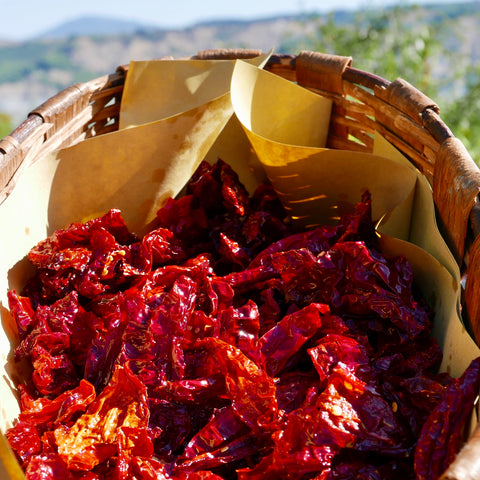
The nameless arcana and the triumph of the Cruschi Peppers
“They had been roasted the much-praised peppers from Purgatory (which Monsignor De Luca, from Lucania, made Pope John taste) kept hanging from the ceilings for months, dried, dusted, crushed, and stored in sacks, finally distributed crispy and red.”
(Leonardo Sinisgalli)

The sculptor Giacomo Manzù managed to create his “Gate of Death” for St. Peter's Basilica thanks to a particular “intercession” coming from Basilicata. This is recounted to us by Giuseppe Palumbo and Giulio Giordano, two Lucanian masters of comics, who inspired by an episode remembered by Leonardo Sinisgalli, tell the story through images.
The Door, a bronze work dedicated to Pope John XXIII, was created thanks to the fundamental intervention of the Lucanian priest Don Giuseppe De Luca who, during a lunch in the Vatican featuring pasta and beans, organized by Pope John XXIII, brought the beans and a bag of sun-dried red peppers and suggested to the nun in charge of the Pope's meals how to prepare them (fried, thus crispy).

Thus, a tureen of pasta and beans arrived at the Pope's table accompanied by a large plate of crispy, shiny peppers that caught the Pope's attention for their appearance and piqued his interest at the moment of tasting.
“A spoonful of pasta and beans and a nice bite of the dried pepper!”
At that same moment, Don Giuseppe told the Pope about Manzù's concern regarding the "Door" project, which had not progressed since 1947 (ten years before the meeting), due to misunderstandings and disputes with a special cardinal commission established to oversee the realization of the work. The Pope then, between one pepper and another, in a good mood from the atmosphere, said to Manzù: “I free you from the ties of the commission, but you must complete the work within a year.” And so it was.

(Detail of the Door of Death)
The mediation of Don Giuseppe De Luca with Pope John XXIII, during this dinner featuring Senise peppers, managed to give the green light to Manzù's ideas (a communist raised under the values of Christianity, who wanted to represent his idea of Christian secularism) and within a year led to the realization of the "Door of Death".
With its intense purple color, medical, chemical, and gastronomic virtues, the Peperone Crusco, also known as "Red Gold," is a true gastronomic excellence, always linked to the literary origins of a strong, passionate, and genuine land: Lucania.
The renowned Lucanian chef, food philosopher, Federico Valicenti, has prepared a recipe inspired by our historical anecdote, which features pasta and beans with crispy peppers.
Click here for the recipe
Maria Teresa Amorosi







